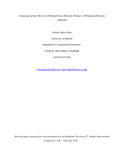Assessing the Key Drivers of Potential Gross Domestic Product: A Production Function Approach
Abstract
Kenya is an emerging economy with agriculture playing a fundamental role in economic
development. The country’s long-term goal is rooted in vision 2030 that envisages an economic
growth of 10 percent. Moreover, the vision places a high premium on stable macroeconomic
environment. Understanding economy’s level of output requires understanding of aggregate
demand and supply. Empirical evidence shows that potential Gross Domestic Product (GDP) is
perhaps the most important indicator of economic activity in a country. Moreover, over the
medium term, the ability of a country to produce goods mainly depends on the physical capital,
employment, and total factor productivity (TFP). However, in the Kenyan context, there exists an
empirical dearth in knowledge on the value of potential GDP and its key drivers. The current
study therefore fills the aforementioned knowledge gap by empirical decomposition of a Cobb
Douglas Production function into TFP, capital stock, and labour attributes. The key drivers of
potential GDP was identified using the growth accounting approach. The study used national
accounts secondary data. Study findings show that labour is the major contributor to potential
GDP at 6.46 percent as compared to 1.27 percent of capital. The study therefore provides
important policy insights on the employment of more units of labour as compared to capital.
However, a balance in the employment of the two factors is important since a well-functioning
supply side requires a balance between the two. It is envisaged that this will drive the economy
along a sustainable path

